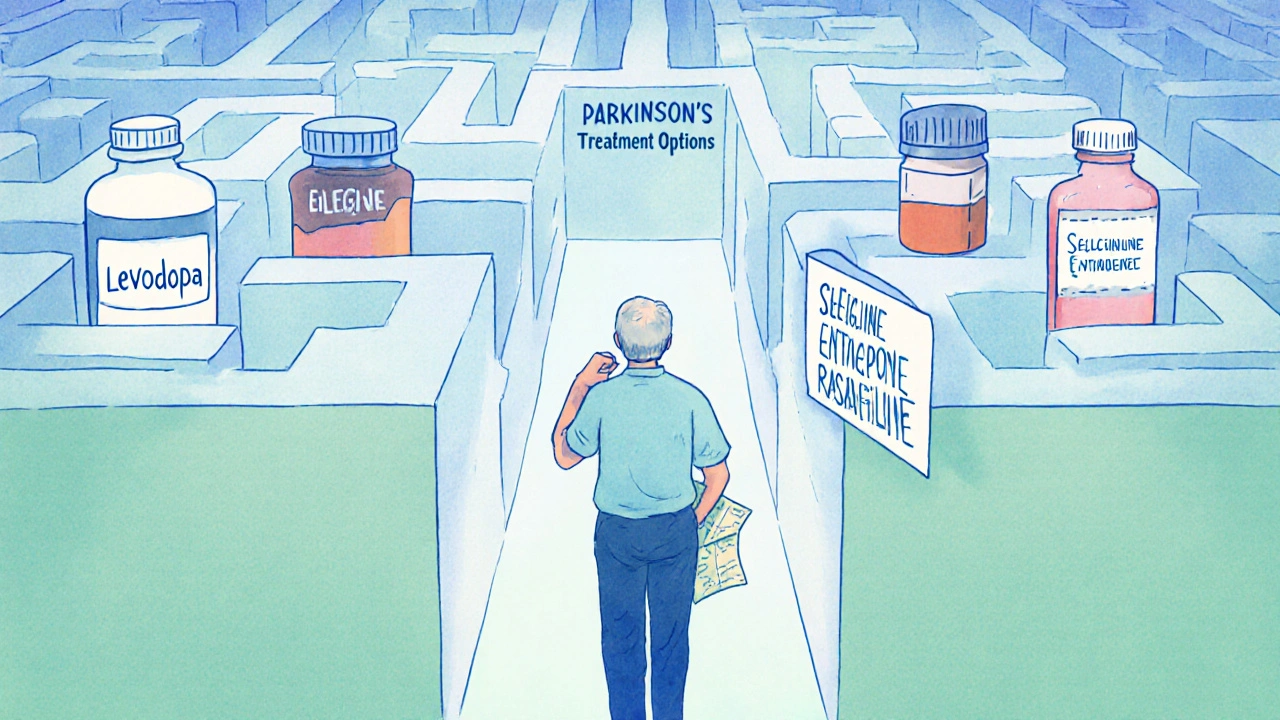Parkinson's Medication Decision Assistant
Choose your priorities to find the best treatment option for your situation
Your Treatment Priorities
Select what matters most to you
Choosing the right medication for Parkinson’s disease can feel like navigating a maze. With new options popping up and older drugs still in play, patients and clinicians often wonder how Azilect stacks up against the rest. This guide breaks down Rasagiline, its class, and the most common alternatives, so you can see which pill fits your daily routine and symptom profile.
What is Azilect (Rasagiline)?
Rasagiline is a selective, irreversible monoamine oxidase‑B (MAO‑B) inhibitor approved by the FDA in 2006 for the treatment of early‑stage Parkinson’s disease. It works by blocking the MAO‑B enzyme, which normally breaks down dopamine in the brain. By preserving dopamine, Rasagiline helps smooth out motor fluctuations without the dietary restrictions that older non‑selective MAO inhibitors required.
The typical dose is 1 mg once daily, taken with or without food. Clinical trials (e.g., the ADAGIO study) showed that patients on Rasagiline experienced an average 4‑point improvement on the Unified Parkinson’s Disease Rating Scale (UPDRS) after six months, compared to placebo.
Common side effects include headache, joint pain, and occasional nausea. Because it’s a potent MAO‑B blocker, doctors watch for interactions with certain antidepressants and over‑the‑counter cold medicines.
Where Does Rasagiline Fit in the Parkinson’s Treatment Landscape?
Rasagiline belongs to the MAO‑B inhibitors class, which also includes selegiline and safinamide. These drugs are usually introduced early in the disease course, either as monotherapy or as an add‑on to levodopa when motor symptoms start to wobble.
Because MAO‑B inhibitors have a modest effect on symptoms but a neuroprotective reputation, they’re often favored by patients who want to delay levodopa initiation-levodopa can cause dyskinesias after years of use.
Key Alternatives to Rasagiline
- Selegiline - The first‑generation MAO‑B inhibitor, available in both oral tablets (10 mg) and a transdermal patch (6 mg/24 h). It also blocks MAO‑B but at higher doses can affect MAO‑A, leading to stricter diet rules.
- Safinamide - A newer reversible MAO‑B inhibitor approved in 2017. It adds a glutamate‑modulating effect, which may help with non‑motor symptoms like mood swings.
- Levodopa/Carbidopa - The gold‑standard symptomatic therapy. Levodopa converts to dopamine in the brain; carbidopa prevents peripheral breakdown, allowing lower doses.
- Entacapone - A catechol‑O‑methyltransferase (COMT) inhibitor used as an add‑on to levodopa/carbidopa to extend its effect.

How to Compare: The Decision Matrix
When you line up Rasagiline against its competitors, five criteria usually matter most:
- Efficacy - Measured by UPDRS score changes or “off‑time” reduction.
- Safety & tolerability - Frequency of side effects and interaction risk.
- Dosing convenience - Once‑daily vs multiple doses or patches.
- Cost & insurance coverage - Out‑of‑pocket price tiers.
- Additional benefits - Effects on mood, cognition, or non‑motor symptoms.
Below is a side‑by‑side table that captures these points for the most widely used options.
| Drug | Typical Dose | Mechanism | UPDRS Avg. Gain* (points) | Common Side Effects | Cost Tier (US$) |
|---|---|---|---|---|---|
| Rasagiline (Azilect) | 1 mg once daily | Irreversible MAO‑B inhibition | +4 (6‑mo) | Headache, joint pain, nausea | $$ |
| Selegiline (Eldepryl) | 10 mg oral or 6 mg/24 h patch | Irreversible MAO‑B (high dose MAO‑A) | +3 (6‑mo) | Dizziness, insomnia, dietary tyramine restrictions at high dose | $ |
| Safinamide (Xadago) | 50‑100 mg once daily | Reversible MAO‑B + glutamate modulation | +5 (6‑mo) | Dry mouth, hypertension, dyskinesia (when combined with levodopa) | $$$ |
| Levodopa/Carbidopa (Sinemet) | 100‑200 mg/25 mg 3‑4×/day | Precursor conversion to dopamine | +10 (early stage) | Nausea, orthostatic hypotension, long‑term dyskinesia | $$ |
| Entacapone (Comtan) | 200 mg with each levodopa dose | COMT inhibition - prolongs levodopa effect | +2 (as add‑on) | Diarrhea, discoloration of urine, orange skin tone | $ |
*Values represent average improvements reported in Phase III trials; individual response varies.
Who Benefits Most from Rasagiline?
If you’re just diagnosed, not yet on levodopa, and want a pill that won’t mess with your diet, Rasagiline is a solid first‑line choice. Its once‑daily schedule also appeals to busy seniors who might forget multiple doses.
Patients who already take levodopa but start experiencing “off‑hours” can add Rasagiline to smooth out those gaps without dramatically increasing dyskinesia risk. The drug’s modest efficacy makes it less suited for those who need a big symptom swing-those folks usually go straight to levodopa.

Practical Considerations for Prescribers and Patients
- Drug interactions: Avoid concurrent use with non‑selective MAO inhibitors, certain antidepressants (e.g., fluoxetine), and sympathomimetic decongestants.
- Monitoring: Baseline blood pressure and liver function tests are recommended; repeat after three months.
- Insurance: Many U.S. plans place Rasagiline in Tier 2, but generic availability can lower the out‑of‑pocket cost.
- Switching: When moving from selegiline to Rasagiline, a 24‑hour washout isn’t required because both are MAO‑B selective, but doctors still verify no recent MAO‑A inhibitors were taken.
Bottom Line: How Does Azilect Stack Up?
Rasagiline offers a sweet spot of efficacy, safety, and convenience for early‑stage patients. Compared with selegiline, it’s a bit more expensive but drops the dietary warnings. Safinamide may edge out Rasagiline on UPDRS improvement, yet its higher price and reversible binding can be a turn‑off for some. When levodopa is already in the mix, adding Rasagiline provides a modest “off‑time” cut‑back without the bitter dyskinesia surge that entacapone sometimes triggers.
Ultimately, the right drug hinges on where you are in the disease trajectory, your tolerance for side effects, and what your insurance will cover. Talk with your neurologist about the trade‑offs, and use this comparison as a conversation starter.
Can I take Rasagiline with antidepressants?
Only if the antidepressant is not a monoamine oxidase inhibitor. Selective serotonin reuptake inhibitors (SSRIs) are generally safe, but MAO‑A inhibitors like phenelzine must be avoided.
Do I need to follow a low‑tyramine diet with Rasagiline?
No. Rasagiline selectively blocks MAO‑B, so the classic cheese‑or‑wine restriction that applies to non‑selective MAO inhibitors is not required.
How quickly does Rasagiline start working?
Patients usually notice a modest improvement in motor symptoms within 4-6 weeks, with peak benefits emerging around the three‑month mark.
Is Rasagiline safe for older adults?
Yes, clinical data show similar tolerability in patients over 75 years old, provided kidney and liver function are monitored regularly.
Can I switch from Selegiline to Rasagiline without a washout period?
Because both drugs target MAO‑B, a short 24‑hour gap is usually enough, but your neurologist should check for any lingering MAO‑A activity from high‑dose selegiline.

9 Responses
Choosing a Parkinson’s medication can feel overwhelming, and it’s completely understandable to feel unsure. Rasagiline’s once‑daily schedule and lack of dietary restrictions make it a patient‑friendly option. Many people appreciate the modest but steady improvement it offers without the need for multiple doses. It’s worth discussing these points with your neurologist to see if it aligns with your lifestyle and symptom goals.
The side‑effect profile looks manageable. Cost is moderate compared to some newer agents.
I hear you on the concern about drug interactions; it’s something many patients worry about. The good news is that Rasagiline generally plays well with most SSRIs, and the diet freedoms are a relief compared to older MAO inhibitors. Keeping an open line with your doctor about any other medications you’re taking can help avoid surprises.
Think of Rasagiline as a steady companion on your treatment journey. It won’t replace levodopa when you need a bigger boost, but it can smooth out those off‑times and give you a bit more confidence in daily activities.
When you look at the data coming out of top‑tier American research labs, Rasagiline consistently shows a clean efficacy signal without the dietary shackles of older MAO inhibitors. Our healthcare system prides itself on delivering cutting‑edge therapies that keep patients moving forward. It’s a testament to the innovative spirit that defines our nation’s approach to neurologic care.
The comparative table underscores a troubling trend: newer agents like Safinamide command a higher price tier despite only marginal gains in UPDRS scores. Ethical prescribing demands scrutiny of whether these incremental benefits justify the additional financial burden on patients. Moreover, the industry's marketing narratives often obscure the modest nature of these improvements.
While the data may appear straightforward, one must consider the hidden influences shaping these studies. Pharmaceutical sponsors have long been known to subtly steer outcomes in favor of higher‑priced products, casting doubt on the true superiority of any "new" drug. It is prudent to approach such claims with a measured skepticism, especially when they align conveniently with market interests.
Whoa, drama alert! You think the pharma guys are just handing out freebies? Nah, there’s always some secret sauce behind the scenes. Keep your eyes peeled, because the plot thickens every time a new price tag appears.
Rasagiline, marketed as Azilect, is an irreversible MAO‑B inhibitor that was approved by the FDA in 2006 for early‑stage Parkinson’s disease. Its mechanism of action involves selective inhibition of the MAO‑B enzyme, which reduces the catabolism of dopamine in the central nervous system, thereby increasing synaptic dopamine availability. Clinical trials, most notably the ADAGIO study, demonstrated an average improvement of four points on the UPDRS after six months of therapy compared with placebo. This efficacy is modest when juxtaposed with levodopa, which can yield improvements of up to ten points in early disease stages. However, Rasagiline’s advantage lies in its once‑daily dosing regimen and the absence of the tyramine‑rich diet restrictions associated with non‑selective MAO inhibitors. The safety profile is generally favorable; the most common adverse events reported are headache, joint pain, and nausea, each occurring in less than 10% of patients. Drug‑drug interactions merit attention, particularly with certain antidepressants such as fluoxetine and with sympathomimetic decongestants, which can precipitate hypertensive crises. Baseline monitoring of blood pressure and hepatic function is recommended prior to initiation and at three‑month intervals thereafter. Cost considerations place Rasagiline in tier‑two formularies in the United States, making it more affordable than newer agents like Safinamide, which occupy tier‑three. Comparative head‑to‑head studies suggest that Safinamide may achieve slightly higher UPDRS gains (approximately five points), but at a substantially higher price point and with a different side‑effect spectrum that includes dry mouth and hypertension. Selegiline, the predecessor in the MAO‑B class, offers similar efficacy but carries a risk of dietary tyramine reactions at higher doses due to partial MAO‑A inhibition. In clinical practice, the choice between these agents often hinges on patient‑specific factors: age, comorbidities, tolerance for potential side effects, and insurance coverage. For patients over 75 years old, Rasagiline has shown comparable tolerability to younger cohorts, provided renal and hepatic function are monitored. When added to levodopa regimens, Rasagiline can reduce "off" time without markedly increasing dyskinesia, offering a useful adjunct for those experiencing motor fluctuations. Ultimately, the decision matrix should weigh efficacy, safety, convenience, and cost to tailor therapy to the individual’s disease trajectory and lifestyle.